After reviewing one of Walker Bays 270 Genesis FTD rigid inflatable boat (RIBs) in the December 2007 issue, Practical Sailor tracked down 11 similar boats from seven manufacturers-ranging in manufacturers suggested retail price (MSRP) from $1,800 to $3,500 and weighing from 92 to 154 pounds.
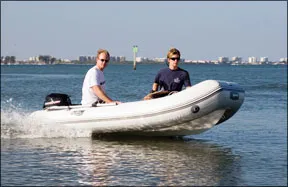
All of the dinghies are about 10 feet long, with beams of about 5 feet. Most have V-shaped fiberglass hulls and are rated for 15-horsepower engines. Nine of them are rated to carry up to four people.
Eight have fixed transoms; the others have transoms that fold-down for storage. In most of the fixed-transom boats, the transoms and decks are one piece, giving them stiffness and strength to hold a 100-pound, four-stroke outboard. The transoms also provide sturdy attachment points for eyebolts for lifting and lowering the boats on davits. The downside is that these boats cannot be stowed as easily as their counterparts. The rigid transom adds weight, too: The fixed-transom models average about 132 pounds. With the exception of one boat, the folding-transom models come in at roughly 93 pounds.
Because the folding-transom types are clearly different products, the field was divided into two groups. This first article will compare the eight RIBs with fixed transoms, and a follow-up will examine RIBs that, like the Walker Bay Genesis line, have folding transoms.
What We Tested
The eight test boats with rigid transoms include two Achilles, the HB310 and the HB315-LX, and two from Groupe Zodiac (makers of the Zodiac and Avon lines), the Zodiac Yachtline 310 and the Avon Rover 315. Rounding out the field are the 10VL from AB, the Caribe L10, the Mercury Dynamic 310, and the Brig Falcon Tender F300.
Tube choices split into two composite fabric types: Duponts Hypalon, an elastomer valued for its proven resistance to abrasion and ultraviolet rays; and PVC, which is lighter, comes in more colors, and can be welded at the seams, instead of glued. The two Achilles, the Avon, the AB, and the Caribe are available only in Hypalon, while the Zodiac comes only in PVC. The Mercury and the Brig are manufactured in both Hypalon and PVC. Practical Sailor recommends Hypalon for tropical or year-round sailing.
The Hypalon models from Avon, AB, Brig, and Mercury are backed by 10-year warranties. The two Hypalon models from Achilles and the Caribe carry only five-year warranties, as does the PVC Zodiac.
Manufacturer warranties are tied to the warranties of the fabrics used to make the boats.
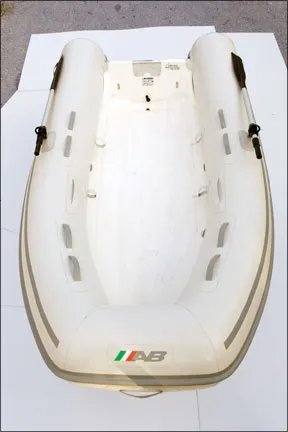
“From what I have seen, most of the manufacturers of the fabric offer a 10-year warranty on their fabric,” explained Stephan Lance, vice president of Defender Industries, a major seller of small boats and engines. “A boat manufacturer will elect to pass on that warranty or will reduce their exposure and offer only a five-year warranty on the fabric after production.”
The eight test boats range in weight from about 112 pounds (the Mercury) to 154 pounds (the Avon).
As for horsepower, makers of the Achilles HB315-LX and the AB 10VL recommend 15 horsepower and say their boats can handle a fifth person. The AB 10VL is the longest at 10 feet, 6 inches, and the pup of the group, the Brig F300, is 9 feet, 10 inches. (Brig suggested its larger F330 would have been more appropriate for this field.)
The AB, Achilles HB315-LX, and Caribe all carry beams of 5 feet, 5 inches. In the all-important category of interior space, these three boats also have the most real estate.
Tube diameter is often promoted as an advantage in choppy water, when the larger tubes are supposed to offer a drier ride. However, a greater tube diameter does not necessarily mean youll stay dry, as other factors also come into play, such as hull design, tube placement on the hull, and the type of rubbing strake. Five of the eight have tube diameters of 17 inches. The Zodiac has 18-inch tubes. The Brig and Mercury have tube diameters of 16 inches.
On the chart on pages 8-9, youll note the variation in maximum loads. They differ because manufacturers may be calculating the weight according to different standards, Lance said. “Few of the inflatable boat makers follow the same formula,” he said. “Some use ABYC (American Boat and Yacht Council) standards, some go by the ISO (International Standards Organization)-and there are a couple different ISO standards that apply.”
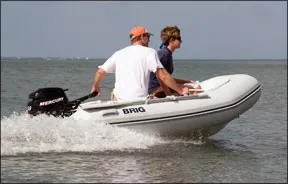
What We Found
Although the smaller boats were slightly wetter in chop, there were no clear standouts in terms of “dry” boats. The transoms flexed very little on the water. Most of the boats are manufactured with fiberglass knees molded into the deck structure to support the transom, and most have a pair of towing eyes glued to the bow for bridle towing.
Only two of the tested boats, the Zodiac and the Avon, have bow lockers, which add a significant amount of weight.
The bench seat on most of the test boats must be installed with the boat slightly deflated. Decks are foam-filled with plugs in the stern for drainage. Most have a recessed bilge area, and two boats have storage compartments. The Avon and Zodiac featured rotomolded anchor locker inserts. Some of the tested boats come in upgraded versions with bow lockers.
Although a tow test was not possible, testers noted that all but the AB, the Caribe, and the Mercury had attachment points for the towing bridle, which our previous tests have shown improve tracking. Some dealers install these bridle rings as an option. A safety line to the center eye is always recommended.
AB 10VL
The AB 10VL is the largest boat we tested. It can handle the most horsepower and is rated to carry five people. Former Practical Sailor editor Nick Nicholson carried an AB around the world with him. Nick said that over the years, some stainless-steel hardware rusted sooner than expected and some of the external glue patches failed, but concluded: “It delivered everything that was asked of it.”
Two large straps on the aft sections of the tubes and one at the bow are used for carrying this boat. The manufacturer also includes eight Hypalon straps on the tube tops for handholds. The lifting rings are mounted on the inboard side of the transom and the foredeck (almost under the inflated tube).
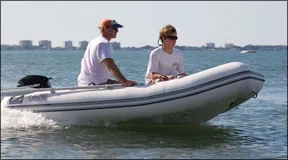
The drain plug has no tether, and the drain is a modest, 7/8-inch in diameter. The deck, which mostly follows the shape of hull, lacks nonskid. The oars can be well secured inside the boat with Velcro straps.
The beefy, single-rail rub strake extends around the tube stern ends, which are unprotected on some other boats.
The AB topped out at 21 miles per hour and stepped onto plane in 7 seconds. Low-speed handling in forward was fine, and it was good in reverse. Testers noted that the boat tended to porpoise at cruising speeds, but eventually settled in and cornered well at slightly higher speeds. A spokesperson for AB said the company was baffled by Practical Sailors observations at cruising speed, and responded that it could be attributed to the boats deeper V-hull and larger tubes deflecting the water.
Bottom Line: This is a roomy boat that is priced competitively. It is relatively light, performs well, and is backed by a 10-year warranty with good dealer support in the Caribbean. It has already proven to be a reliable, durable tender, even in tropical climates.
Achilles HB310
At 126 pounds, the HB310 is one of the lighter RIBs tested. The carrying handles are large and well-placed for three-person transportation-two at the stern and one at the bow. Two people, one positioned on each side, can also easily carry the boat using one of the aft handles and one of the forward padded straps. The plastic handhold for the driver is well placed, on the inboard side of the starboard tube, just forward of the drivers seat. Each oar is fixed to T-bracket that rotates down for storage, but does not allow the oars to slide in or out. Rubber clips hold the paddle end of the oar.
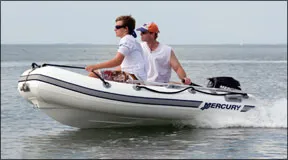
The lifting rings are mounted to the inboard side of the transom and in the foredeck. Along the centerline, the deck is flat, but it follows the hulls deadrise as it extends outboard, making for less level standing area in the bow than some of the other test boats. There is a tie down for the gas tank.
The HB310 has a wooden bench seat amidships. The drain plug is inserted from the outside and is attached to a lanyard. The drain hole is larger than those on most other boats-1 inches in diameter.
The beefy, two-rail rub strake should endure countless connections with docks, boats, and other hard objects. The boat has no storage compartments but has excellent handholds.
On the water, the HB310 hit 21 miles per hour at wide-open throttle, tying the AB 10VL for top-speed honors. The HB310 would not plane unless the two testers put their weight forward, then it did so in 5 seconds.
Testers found the Achilles harder riding than others in the field. It slid slightly during high-speed turns, and in general, it bounced around more. High- and low-speed maneuvering was excellent.
Testers like the cupped blades and the sturdy mounting system for the oars, but the hinge-type oarlocks make rowing tougher.
Bottom Line: The Achilles HB310 has only a five-year warranty, and other boats offer smoother rides, but the boat is well-built and street prices are very competitive, making it a good buy for bargain-hunters.
Achilles HB315-LX

The Achilles HB315-LX is clearly wider at the bow than its smaller brother, the 310, increasing interior volume. Its springier shear suggests a drier ride, and our testing bore this out. The HB310s tube end caps are pointed as well, compared to the HB315-LXs rounded ones.
This model has padded Hypalon straps at the bow and stern quarters for carrying. Six more straps dot the top of the tubes, providing handholds while underway. Although our test boat had different oars, the new HB315-LX has the same oars as the HB310.
The deck is flat and covered with nonskid along the centerline. It offers no storage but does have two lifting rings on the inboard side of transom and one on deck at the bow. (A heavier bow-locker version, the HB315-DX, is also available.) The boat comes with two eyes for a towing bridle and a third eye at the bow to attach an anchor rode. The drainage system is the same as the HB310s. The rub one-channel rub strake is adequate.
The HB315-LX was the most maneuverable in reverse of any boat tested. This RIB was plenty fast, with a top speed of 20 mph. It hopped up on plane in 7 seconds. The lip on the transom plate made it hard to remove the engine.
The boat delivered a smooth, bone-dry ride. Practical Sailor was pleased with the boats outboard-powered performance.
Bottom Line: The Achilles HB315-LX rides smoothly and handles well at all speeds. It is our Best Choice in this category, although wed like to see it backed by a 10-year warranty.
Avon Rover 315
Featuring newly redesigned tubes, the Rover 315 was the heaviest boat we tested. Both it and the Zodiac are built using a closed-mold injection, foam filled, fiberglass construction, which ensures more consistent fiberglass-to-resin ratios and total weight. For its length, its narrower than the other boats, with a beam of only 5 feet, 1 inch. (Only the Zodiac is more narrow.)
Testers liked the pivoting, hard-plastic carrying handle on the bow, but they found the aft handles-Hypalon straps mounted on top of the tubes-less comfortable to grip than those on other boats. Hypalon straps also hold the oars on the tube tops. The handle ends of the oars are held by tying elastic hooks around them. The oars can also be stowed inside the boat, alongside the tube.
Nonskid covers the flat deck. The bow locker is a rotomolded polyethylene insert. This raised anchor/storage locker also doubles as a seat. Theres also a wooden bench seat forward of the oarlock holders. The drain plug is inserted into a 3/4-inch diameter drain hole inside the boat. The plug is tethered to the transom plate to keep it from being lost.

With three people, carrying the Avon was no problem. Two people lift the stern using the handles on the top of the tubes, and a third hoists the bow with the plastic handle.
Four stainless-steel lifting rings are fitted in the deck, making it easy to attach the boat to stern-mounted davits from inside the boat.
In our performance tests, the Mercury 9.9-horsepower outboard pushed the boat out of the hole and onto plane in 8 seconds. Top speed was 19 miles per hour. Handling at low speed was excellent, especially in reverse. At cruising speed, the boat cornered with minimal stern sliding. The handhold for the driver is, in our opinion, too far aft to be useful. Ride quality was good but a little bouncy, our testers reported. Testers also found the boat more difficult to row than others.
Bottom Line: The redesigned Avon Rover 315 was the most expensive boat tested, but it scored only average in many evaluation points. It continues the models workhorse tradition, but its heavy weight is a drawback for a boat-stored tender. On the plus side are a bow locker, a wide service network and a transferable 10-year warranty.
Brig Falcon Tender F300
The Brig Falcon-with a 9-foot, 10-inch length and 16-inch tubes-was one of the smaller boats in our test group. (The company also makes a larger F330, which is just shy of 11 feet.) Despite its small size, the Hypalon F300 is relatively heavy. Brig attributes the extra weight to the boats twin-shell hull construction and reinforced transom.
The three carrying handles on the Brig have sharp edges and were uncomfortable to our testers hands, although the rub rail itself can be used to lift the boat. There are no handholds on the tubes, but there are two grablines, one on each tube.

Nonskid covers the Brigs flat deck. A lifting ring is mounted to the foredeck and a second set of rings is bolted through the transom.
Our test boat came with two wooden bench seats, which testers noted were “wobbly” in their plastic holders on the tubes. The oars fit securely in their rubber seats for tube-top stowage. The oars are fixed in oarlocks that don’t allow them to be feathered or moved in or out. The large drain plug is inserted from the outboard side of the transom but it has no lanyard. On the bright side, the drain hole is a full 2 inches in diameter, allowing for quick drainage. The rub strake needs some fattening up, in our view.
On the water, the boat would only plane when the passenger leaned forward. Then, the Brig stepped on plane in 5 seconds. The boat steered nicely in reverse.
At a slow speed in forward, some water spilled over the top of the transom when turning to starboard. The boat cornered well in high-speed turns, and the ride quality was average but a little bumpy, testers noted. It had an average rowing performance, but hit 20 miles per hour at full throttle.
The builder backs its Hypalon boats with a 10-year warranty and offers six years of coverage for the PVC version.
Bottom Line: The Brig has a competitive price and strong warranty going for it, but it fell short of others on several evaluation points.
Caribe L10
The 127-pound Caribe L10 has three unpadded carrying straps-two at the stern on top of the tubes and one at the bow below the rub strake. Two lifting rings are bolted to the inboard side of the transom. The third ring, bolted to the foredeck, is far enough forward that you wont catch your feet on it.
The aluminum oars are longer than those on most other test boats. The oarlocks and straps on the aft ends of the tubes hold the oars on top of the tubes. Velcro straps on the tubes, near the deck, hold the telescoping oars inside.
The oars also can be stowed in a pouch under the fiberglass helm seat. (Most of the other boats have wooden seats.)
A pair of rubber pads glued to the aft portion of the tubes provide grippy areas for the driver to sit. This helps keeps the driver in place, even if hes in a wet bathing suit. The pads also act as chafe guards, protecting the tubes from riders clambering on and off the boat.
Caribe provides three handholds on the top of each tube, beginning inboard of the
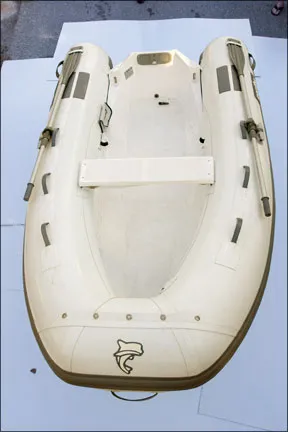
oarlocks and moving forward. Like the carrying straps, they are not padded and are a bit hard on the hands. The deck has no nonskid. Our test boat had just one towing eye, no towing bridles. The drain plug is inserted from inside the boat, but there was no lanyard with our test boat.
At 17 miles per hour, the Caribe was the slowest in the group. The boat handled nicely at low speeds and in reverse, however. The Caribe also performed well once it got up on plane, turning without sliding. The large oar blades and round-eye oarlocks made it one of the better rowers.
Bottom Line: The Caribe is one of the more expensive boats in our group and offers only a five-year warranty, but it offers a good combination of interior volume, smooth ride and light weight.
Mercury Dynamic 310
At just 112 pounds, the Mercury is the lightest Hypalon boat tested. It lacks the interior room of many of the other boats, with an inside length of only 6 feet, 4 inches.
The carrying handles on the Mercury dwarf those on the other boats-and theyre made of softer, easier-on-the-hands rubber. Instead of mounting handholds on the tubes, Mercury rims the entire boat with grab lines. This puts handholds within easy reach, but the lines are not as easy to hold on to as straps.
Mercury offers four lifting rings to work with-two on the inboard side of the transom and two on the foredeck (out of the way).
The Mercury also has a large drain hole-1-inch diameter. The oars can be securely fastened to the top of the tubes, but wed prefer a storage option inside the tubes. The paddle ends are securely fastened down with bungee cords. The Mercury lacks towing eyes, and the thin rub strake could use some more meat, in our opinion.
On the water, the Mercury hit a top speed of 19 miles per hour and planed in 10 seconds. The testers had to lean forward to get the boat to plane. In reverse, the port tube became submerged, and the boat took on water where the transom meets the tube. The boat slid slightly in high-speed cornering, but the ride was relatively soft. Testers had no problem rowing the boat.
Bottom Line: Testers liked many of the deck features-the carrying handles and oversized drain plug-but performance was lackluster. This is the least expensive Hypalon boat in the field.
Zodiac YL310
The only boat with 18-inch tubes, this new Zodiac is the narrowest boat in our group and the lightest. Practical Sailor thought the handholds were positioned in all the right locations for easy two- or three-person carrying. The handholds can be moved fore and aft along a nylon strap.
The flat deck has a grippy, raised-diamond nonskid. The padded bench seat can be moved aft or amidships.
The oars clip into a plastic block that pivots down for storage. Another set of slide-on clips are meant to keep the oar ends in place near the stern. These need to be installed correctly or the oars will come loose underway. An illustration in the

0 )]manual indicates correct installation.
The Zodiac has four lifting rings, all on deck, making them easier to secure to a davit. The rotomolded anchor locker was nicely tooled. Testers liked the rub strake. The inside drain plug has a lanyard.
The Zodiac shined in performance testing. The boat cornered with precision, generated no spray, and delivered a very smooth ride compared to the other boats. Its fast, too, topping out at 20 mph. The Zodiacs trim angle was noticeably more sensitive to weight placement compared to some of the other boats its size others in the test. Time to plane was 7 seconds.
Bottom Line: The Zodiac hits the mark in several areas, including ride quality, handholds, storage, and deck traction. The fuel-tank tie down is a nice touch. While Practical Sailor is not a fan of PVC in the tropics, this boat is a top contender if youre intent on having a bow locker and live in temperate climates.
Conclusions
Differences between these boats were often subtle, but ultimately four boats stood out above the rest: Zodiac Yachtline 310, AB 10VL, the Caribe L10, and the Achilles 315-LX. Though relatively heavy, the Zodiac Yachtline 310 stood out for its performance, features, and finish. If you live in a temperate climate where the PVC hull will see reduced sun exposure and like the idea of a bow locker, this Zodiac will serve you well. In our view, those in tropical climates should narrow their selection to the Hypalon boats. The AB 10VL and Caribe L10 both do a good job of combining light weight, plenty of volume, and a dry ride. Testers gave the Caribe a slight edge over the AB, but the AB is bigger and faster. Except for a 10-year warranty, the Achilles HB315-LX has all the features testers desire in tender. As a bonus, the boat is priced very competitively. It is a clear Practial Sailor Best Choice in this category.
Pet Peeves
After testing eight of these lightweight RIBs, some common deficiencies became apparent.
Oars-While these boats are not meant to be rowed, manufacturers should pay more attention to their oars and oar stowage. Ideally, there should be a method of securing the oars inboard, where they are almost impossible to lose.
Rub strakes-Theres no reason to outfit these boats with thin rub strakes. A couple of the boats had very anemic protection.
Fuel-tank tie downs-Although easy to retrofit, fuel tank tie-downs are also a plus. Only four of our test boats offer tie-downs-the Zodiac, Avon, and both Achilles RIBs.
Performance-Consumers should remember that these boats are extremely weight sensitive. Use caution, especially at high speeds.
Weight-Our test boats are classified as “lightweight RIBs,” but most fail to live up to that moniker. The average weight of the test boats: 132 pounds, a lot to drag around. Our upcoming review of folding-transom RIBS features lighter boats.
Stowage-These boats occupy significant real estate on deck, so they often wind up hanging from davits at the stern of the boat. Placing significant weight, windage, and a potential wave catcher at the stern of a boat can have serious consequences in heavy weather. Practical Sailor does not recommend stowing a dinghy on davits for ocean passages. Unless Youve got a very big boat, with very big locker, they should be lashed on deck to padeyes installed to withstand significant loads.
Speed-Finally, if you want to plane on the bigger boats with three or more people, opt for a 15-horsepower engine. Be aware, however, that a small RIB with a big engine is a potentially dangerous combination, particularly with just one person on board. The thrill of a 20-knot ride can be-literally-paralyzing.
































